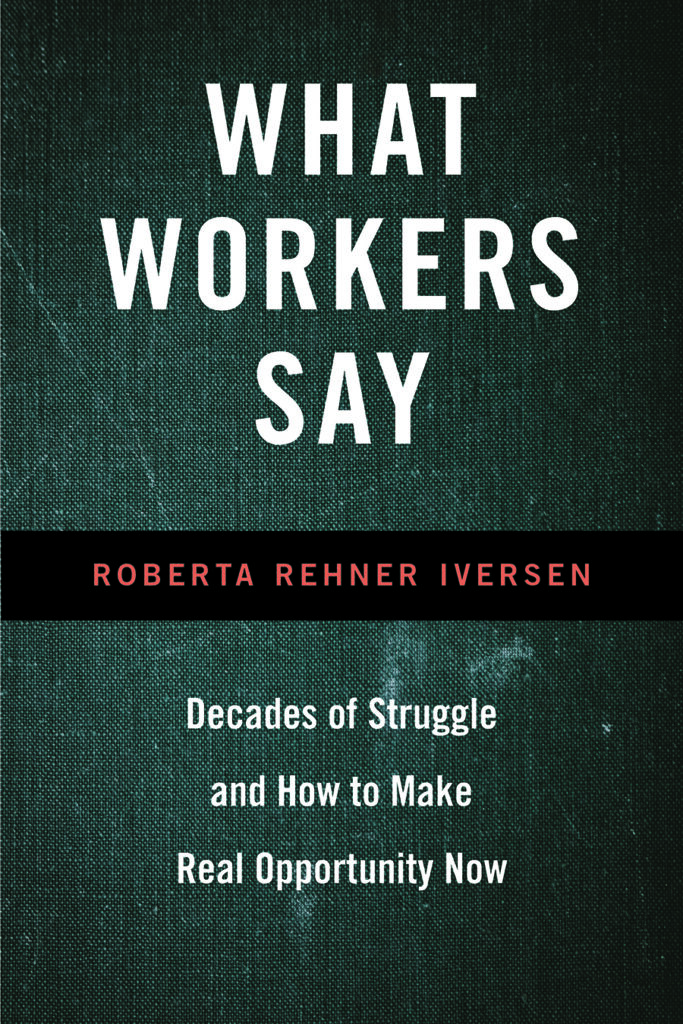
A common question when meeting someone new is asking them, “What do you do?”
People’s work, and the labor market more broadly, occupy millions of people’s lives in the U.S. and around the globe. But why is “What do you do?” often the first question? Of course it’s partly because most people need the money that work provides—and often need more money than their particular labor market job offers. It’s also because what we “do” is often shorthand to others for “who we are.”
Yet “who we are” does not begin to touch the lack of opportunity in many of today’s labor market jobs, whether in manufacturing, printing, construction, healthcare, clerical work, retail, real estate, architecture, or automotive services. These are occupations and industries that have employed nearly two-thirds of the U.S. workforce since 1980, as workers in these areas since the 1980s until today vividly describe in my new book.
For my book What Workers Say, I talked to 1,200-plus people at length since the early 1980s, some of them repeatedly, regardless of what occupation they hold or industry their job is in. They have all recognized that there’s little to no opportunity for promotion or advancement in their jobs, despite the fact that people, their communities, their families, and their country as a whole, need what these workers do. At the same time, too many of them are also not paid a living wage.
The workers in the above-mentioned occupations and industries—regardless of socioeconomic characteristics—typify the types of struggles, discouragement, and on-the-job injuries that continue to affect millions of workers in the U.S. and elsewhere. Just as Studs Terkel’s Working valuably introduced the populace to what many jobs and occupations were like across the U.S. up to the early 1970s, the workers in What Workers Say describe their jobs and occupations from 1980 to today—a period of rapid and tumultuous labor market change.
For example, Tisha [a chosen pseudonym, like all of the worker’s names] in manufacturing, Joseph and Randy in construction work, and Kevin in a printing job, are among those workers who vividly illustrate the shift to service occupations from the earlier, higher-paying manufacturing occupations.
In one of the most dramatic examples of this shift, 40-year-old, African American, Hard Working Blessed, experienced multiple eye injuries on his manufacturing job, which resulted in demotion and severe wage reduction. He ended up as a Fast Food Manager, with lower pay and a job that did not make use of his extensive work experience in manufacturing. Clerical workers, such as Roselyn, Wendy, Ayesha, Susan and others similarly describe struggling with frequent recessions and layoffs over the period. Others, including Noel, Tom, and Shanquitta (for a period), describe frequent job disruptions and store closures from the increase in offshoring jobs to countries that pay workers even less than the U.S. does.
And many healthcare workers, such as Laquita, Tasha, Martina, and Annie and others experience “credential creep,” where higher-level education became a hiring requirement, even though the demands of the job were suited perfectly to these applicants’ current credentials. This, of course, resulted in new forms of inequities in hiring.
In short, the workers tell the real story about today’s jobs so others can know what these jobs are really like. The richness and depth of the workers’ words help readers to understand that the formal definition of “unemployment” is very strict and does not cover many people who have been laid off or who aren’t able to look for work. Their words also illustrate the fact that since the 1980s there often haven’t been enough jobs for all who want labor market work, and that the default social policy response to low pay has been person-oriented: that more education and more skills are what is needed for greater equity in the labor market.
In some cases, the coronavirus pandemic has illuminated the low-pay issue, to the benefit of current workers, but not in all cases and not necessarily to the level of a living wage. These workers also vividly describe what they’d really like to be doing, which leads in the final chapter to a solution that I call “compensated civil labor.”
Drawing on German sociologist, Ulrich Beck’s idea of civil labor, I add “compensated” to the idea of civil labor. Compensated civil labor expands what we think of as work, how we do work, and particularly, how we do paid work. Compensated civil labor would allow the many people like Teresa to work at her rental car company part-time and satisfy her “heart-string” (aka her passion) of part-time food catering to her church, children’s school, and community and also be compensated for doing it. Compensated civil labor could also enable expansion of the notion of “work” well beyond the labor market in ways that can tap into today’s workers’ desire to engage in environmental protection activities, broader family participation, community contribution, and the like.
In short, compensated civil labor would mean compensating people for their non-labor-market work, whether by actual money, exchange, or other forms of compensation. Data in the 2000s from the Bureau of Labor Statistics’ Current Employment Statistics Survey and the Current Population Survey, together with numerous existing civic examples, aim to stimulate civic leaders, philanthropic foundations, educators and others to consider compensated civil labor, which could benefit workers, families, communities, and countries alike.
Read More
Roberta Iversen. What Workers Say: Decades of Struggle and How to Make Real Opportunity Now. Temple University Press 2022.
An earlier version of this post has been published on North Philly Notes.

No Comments